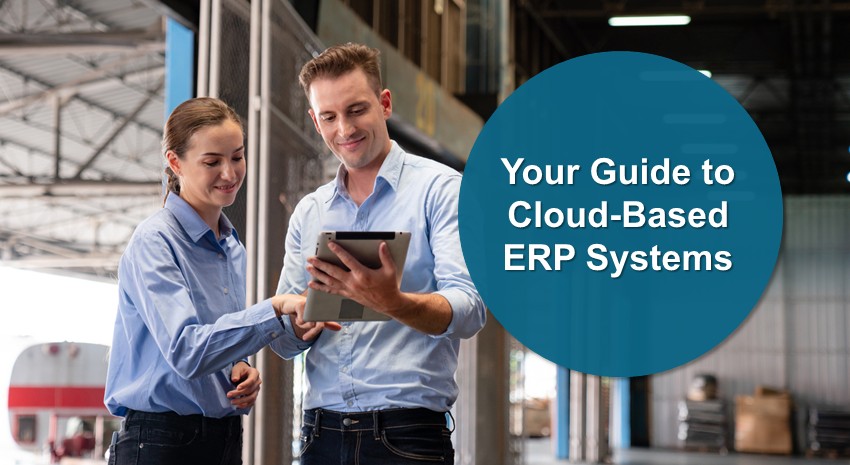Your Guide to Cloud-Based ERP Systems

Businesses use enterprise resource planning (ERP) software to manage essential parts of their operations. The platform can integrate core business processes, like finance, human resources, supply chain management, and customer relationship management (CRM), into one unified system.
Due to the benefits of cloud-based ERPs, most businesses are moving away from traditional on-premises systems. However, before taking that crucial step, it’s best to compare the two and learn why a cloud-based ERP is ideal.
What Is a Cloud-Based ERP System?
A cloud-based ERP system integrates and manages core business processes through a web-based platform hosted in the cloud. Unlike traditional on-premise ERP systems that require local servers and infrastructure, cloud-based ERP solutions are accessible online. This capability allows you to use the software without extensive hardware investments. You can also outsource hosting and maintenance operations.
Businesses can use cloud-based ERP systems for various functions, such as:
- Project management.
- Supply chain management.
- Operations management.
- Financial management.
- Service management.
Cloud-based ERP systems typically use a subscription model. You pay a recurring monthly or annual fee to access and use the platform while the vendor manages and maintains it. These cloud-based ERP systems delivered over the internet are considered software as a service (SaaS).

Types of Cloud-Based ERP Software
There are different types of cloud-based ERP software. Two common examples are:
- Single-tenant SaaS: Each customer has their own instance of the ERP software. This model allows for greater customization and control but typically costs more.
- Multi-tenant Saas: One software instance serves multiple customers, so they share resources and infrastructure. This model typically offers lower costs and easier maintenance but may have limited customization options.
When choosing a cloud-based ERP system, consider your organization’s needs, industry requirements, budget, and growth potential to maximize the benefits.
Cloud-Based vs. On-Premise ERP Systems
Choosing between cloud-based and on-premise ERP systems is a critical decision. Below is a comparison covering various aspects.
1. Deployment & Infrastructure
Cloud ERP systems are hosted on remote servers managed by third-party providers or vendors. Users access the software on the internet. Organizations do not need to purchase or maintain physical servers or infrastructure, reducing upfront capital expenditures. In contrast, on-premise systems are installed and run on the organization’s own servers and infrastructure. Organizations must invest in hardware, software licenses, and IT resources for installation, maintenance, and support.
2. Cost Structure
Cloud-based ERP systems are usually offered on a subscription basis, and the costs scale depending on usage or the number of users. The initial investment is generally lower, making it more accessible for small and medium-sized enterprises (SMEs). On-premise ERP systems often require significant upfront investments. Organizations must also budget for ongoing maintenance, upgrades, and IT support, which can add to long-term costs.
3. Customization & Control
While many cloud ERPs offer customization options, they may not provide the same flexibility as on-premise systems due to their shared infrastructure. Organizations using cloud ERPs have less control over the underlying infrastructure and software environment because the cloud provider manages that. On-premise ERPs provide greater control over system, data, and security protocols.
4. Maintenance & Updates
Vendors manage software updates and maintenance, so organizations often have access to the latest features and security patches. This service allows businesses to focus on their core operations. Organizations using on-premise ERPs are responsible for managing updates. This arrangement often requires a dedicated IT team.
5. Accessibility & Mobility
Users can access cloud-based ERP systems remotely with an internet connection. Most also have mobile applications, which employees can access on the go. In contrast, on-premise ERPs generally have restricted access unless additional solutions like virtual private networks (VPNs) are implemented. Again, they often lack mobile functionality compared to cloud solutions.
6. Scalability
Businesses can easily scale cloud ERP systems to accommodate growth. They can add users, modules, and functionality or adjust the subscription levels based on current needs. Scaling on-premise ERP systems often requires additional investment in hardware and software. Adding new functionalities or modules can also be time-consuming because of the need for installation and configuration.
What Are the Advantages of Cloud-Based ERP Systems?
Businesses are moving to cloud-based ERPs because of the benefits they provide. Here are three examples.
1. Simplified & Regular System Updates
Cloud-based ERP systems receive regular updates, which are sometimes automatic. This feature gives users access to the latest functionalities and security patches with limited or no manual intervention. Since the vendor manages the updates, users experience less downtime than on-premise systems.
2. Reduced Maintenance Costs & Responsibilities
The vendor maintains and upgrades the cloud, meaning you can shift your IT resources to other vital areas. This strategy takes the load off your shoulders and can also reduce costs. You can leverage the provider’s expertise and resources without spending much on infrastructure and a dedicated team.
3. Improved Data Security
Cloud providers typically implement advanced security protocols to protect sensitive business data. These include data encryption, firewalls, regular backups, and the implementation of identity and management (IAM) policies. Furthermore, many cloud ERP systems have features that help organizations comply with industry regulations and standards, simplifying the management of compliance requirements.
Potential Challenges with Cloud-Based ERP Systems
While cloud-based ERP systems have many benefits, there are potential downsides.
1. Change Management
Transitioning to a cloud ERP system can be complex. Changes in processes and workflows can also cause resistance from employees. To solve this problem, organizations can provide thorough training to help employees adapt to the new system and understand its benefits.
2. Integration with Legacy Systems
Integrating cloud ERP with existing legacy systems can be challenging and typically requires time and resources. As a best practice, consider assessing the existing system and planning for integration during the ERP selection process. You can also use middleware or integration platforms to facilitate communication between the cloud ERP and legacy systems.
3. Dependence on Internet Connectivity
Cloud ERP systems require a stable internet connection. Poor connectivity can lead to downtime, slow performance, and reduced productivity. Therefore, investing in high-speed internet connections and ensuring redundancy is essential. Also, consider cloud ERP solutions that offer offline capabilities or local catching to allow users to work even when internet connectivity is disrupted.
Microsoft Dynamics 365 Business Central ERP
Microsoft Dynamics 365 Business Central is an advanced cloud-based ERP system that gives modern businesses the tools and workflows to integrate operations and connect functions across the enterprise. It streamlines operations management, enhances customer service, and strengthens business intelligence and reporting. Each Dynamics 365 Business Central module enables comprehensive custom configuration and connectivity to improve functions within your business.
Start Your Cloud-Based ERP Journey with ArcherPoint
ArcherPoint is a Certified Microsoft Dynamics Solutions Partner that helps businesses like yours migrate from their on-premise ERPs to a SaaS environment. We have a dedicated team ready to assist you in finding the best solution. With more than 20 years of industry experience, we understand diverse business needs and can leverage that to develop a personalized strategy. Contact us today to learn more!

Trending Posts
Stay Informed
Choose Your Preferences
"*required" indicates required fields
